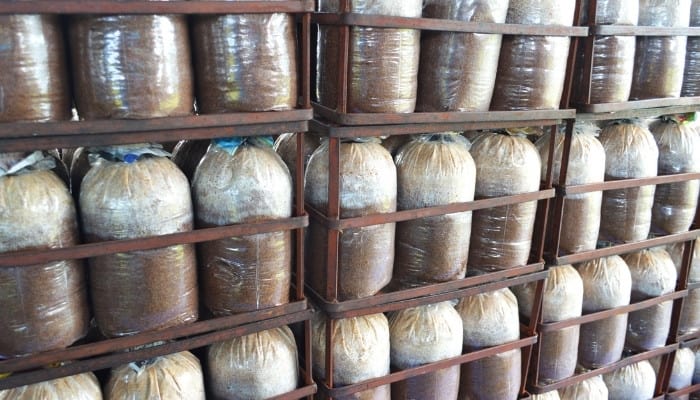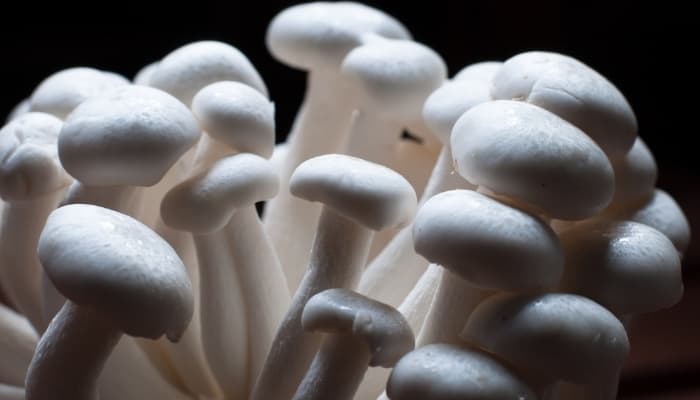Typically, dark areas are not conducive to the success of garden creatures. However, the mushroom is one exception to this norm.
Its love of dark, warm spaces makes it perfect for an apartment or other indoor space, but is growing mushrooms feasible as far as costs are concerned?
How much does it cost to grow mushrooms? The cost of growing mushrooms depends on factors such as the type of mushrooms and how many you want to grow. Personal use production may cost between $60 and $200 per month. For a business venture, costs include equipment, operating space, licenses, and more and may run $2,000-$3,000 per month.
In the following, we’ll will break down all the costs and cover mushroom types, growing mediums, and many other important factors.
By the time you finish reading, you’ll have a realistic idea of what exactly is involved, whether you’re interested in just producing a few mushrooms at home or starting up a new business.
Growing Mushrooms at Home: Setup & Costs
You are likely not going to produce a big crop at this scale. This isn’t just because of the size of your home.
Mushrooms need a specific environment to grow in that is dark and cool. Unless you have a large spare room you can keep this way, you’ll probably be limited to a smaller space, like a closet.
What You’ll Need To Get Started
If you want to skip the difficulties and intricacies of starting from scratch, then you should try buying a mushroom kit, like this complete package for oyster mushrooms.
Beginners can also find this method useful.
However, you may also want to have more control over the quality level and properties of your supplies by taking the DIY approach and securing all needed supplies individually yourself.
This article will go over both techniques.
Mushroom Growing Kit (Basic)
What’s (typically) included:
- Spores
- Substrate
- Instructions
The actual components of a mushroom kit can vary depending on the price. At the basic level, a kit will include a “fruiting block.”
This is a block of spores and substrate that is ready to grow with the addition of water. As the block comes in a bag, you won’t need a container.
A seedling heat mat, soil thermometer, spray bottle, and knife will still come in handy, however.
Individual Items
Spores or Spawn
Unlike plants, mushrooms don’t grow from seeds. Rather, they grow from spores. These differ from seeds in that they do not require both a female and male gamete to form.
You can purchase these spores from online specialty stores or go the slightly easier route and purchase mushroom spawn, which is mycelium that is ready to be inoculated in a substrate.
Make sure that you check the reviews to make sure that the sellers are reputable.
Otherwise, you might find yourself with mushrooms of different species or unhealthy strains.
Substrate
Different mushrooms require different growing mediums. Store-bought potting soil rarely has enough nutrition for mushrooms, so it’s best to use what each type of mushroom likes most.
To simplify things, this guide will only include the substrates for a few different mushrooms (shiitake, button, oyster, and portobello).
The most commonly used substrates include straw, hardwood sawdust, and perlite.
Planting Tray, Bucket or Bags
There are a few options for where to grow your mushrooms.
If you want to use a planting tray, mushrooms will grow best in plastic or wood planting trays that are around 14 x 16 inches and 6 inches deep.
Plastic buckets should be 5 gallons and plastic bags should be 3 to 5 gallons. Another option is to set up a simple mushroom fruiting chamber.
Going with what is within your budget is best. Also, remember that you don’t need to buy more professional planting trays.
Making one yourself or buying a cheaper version from a dollar store is likely also possible.
Just remember that all these containers will need holes in the bottom of the sides. This will help with air flow and moisture.
Seedling Heat Mat
Spores need to be heated before they begin to fruit. A seedling heating pad is the best tool to use for this process.
You may feel the temptation to buy a cheaper regular heating pad. However, manufacturers have not made these to handle moisture. Therefore, they may malfunction when used for other purposes.
I like and recommend this heat mat because of its even heating, reliability, and accurate sensor probe.
Thermometer
The substrate temperature needs to be adjusted as your spores grow. Once you plant them, you need to keep them around 65-70℉.
Once fruiting begins, you need to lower that temperature to around 55 to 60℉.
Sharp Knife or Gardening Shears
It’s likely that you already have either of these in your home. You will use these tools to harvest your mushrooms after they have grown.
It’s not a good idea to pull mushrooms out of the substrate as it can harm the surrounding growth. The cost of these items depends on their quality.
Optional: Isopropyl Alcohol
You need to keep your hands sanitized while you’re mixing the substrate. This will stop your hands from infecting it with mold. This will take nutrients away from your mushrooms and possibly kill them.
You can keep your hands clean with soap, but the best way to kill mold spores is with isopropyl alcohol.
Optional: A Spray Bottle
When you’re growing mushrooms, the substrate needs to remain moist at all times. You can moisten the substrate with a cup; however, this will likely result in uneven moisture distribution.
Using a spray bottle to mist the area will help you keep this from happening.
Expected Costs
Keep in mind that prices will vary widely depending on the size of your order, the type of mushroom, and the individual seller.
Small-Scale Commercial Mushroom Growing: Setup and Costs

On top of the supply costs as mentioned above (this will probably be on a larger scale), there are possible other costs that come with starting a small business.
This section will cover a few things that you may need when you start a mushroom-growing business.
What You Need To Get Started
If you want to keep your business model small, you can probably just sell your crop through an online store and grow it within a special space in your home.
However, this will probably not grant you the same level of profit that a larger business with a website, employees, and a large rented space will grant.
This list is more for business owners who wish for the latter type.
Website
Having your own website can give you complete control over much of your sales and marketing.
You can keep most of the profits of your sales and use web design skills to give your business a certain look. You can’t do this easily with a sales site like Amazon.
Rent
If you have a lot of spare space in your home, you probably won’t need to rent another space. If you don’t, a rented space might help you expand your crop yield.
Advertisement
You can get creative with this and make it as low cost as possible. It’s probably best that you find some way to let people know that your business exists.
However, it’s recommended that you spend around 2% of your total sales on this.
Expected Costs
Related Questions:
Is Growing Mushrooms Cheaper Than Buying Them?
Growing mushrooms can be less expensive than purchasing them, but it really depends on several factors.
How much you save depends on the mushroom species and how many you grow.
Some mushrooms have better biological efficiency than others. You will get more mushrooms from certain species than others.
What Is the Easiest Edible Mushroom To Grow?
Oyster mushrooms are the easiest edible mushroom to grow. This is mostly because they aren’t picky about their substrate.
You can easily grow them on a cheaper material like straw or used coffee grounds. They grow quickly with little effort and are perfect for beginners.

